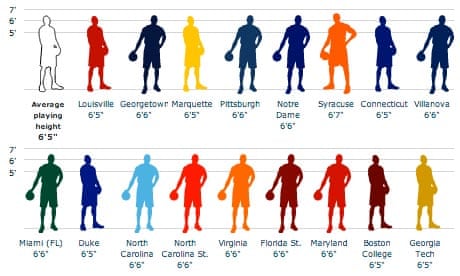If you're like most Americans, you are filling out your office or online NCAA basketball tournament bracket and have absolutely no clue what's going on. You've watched maybe a few games all year, but are filled with the hope of knowing that the tournament can be more unpredictable than toddlers when you take away their candy.
Perhaps you've looked at a website or two that purports to use statistical equations to find the cinderella team. Perhaps you are choosing off the teams' colors. Or maybe you're just a sucker for teams based in state capitals.
But have you ever thought about utilizing a team's height? It makes sense if you think about it. Basketball players are known to be tall, so shouldn't the taller teams have some sort of a statistical advantage?
What we've done in our interactive is plot the average playing height of each team against the percentage of games won by each of the 347 Division I teams during the 2012-2013 season. That means we look at how many minutes each player spent on the floor for each team, so that we won't get fooled by teams that have a lot of short or tall players who see no playing action.
As it turns out, college basketball teams that are taller are likely to win more games than teams that are shorter. For every extra inch in the average playing height of the team, they are expected to win a little more than two games more than they would have otherwise -- highly statistically significant. Height alone explains more than 11% of the differences in a team's winning percentage.
Using our interactive you can breakdown by top-25, conferences, and tournament teams. You may note that the only top-25 team who falls far below the average playing height of six feet four inches and a half is Kansas State. You can see that most teams in the Atlantic Coast Conference (ACC) tend to follow the general trend of height improving win percentage, except for the outlier Duke.
Indeed, the 68 tournament teams are 0.65 inches taller on average than non-tournament teams. The average playing height in the NCAA this season was 76.6 inches, while the average playing height of the tournament teams is 77.13 inches and of non-tournament teams is only 76.48 inches. 75% of tournament teams have an average playing height of at least 77.65 inches, while only half of all teams do. Half of all tournament teams having an average playing height of at least 6 feet 5 inches, while only a quarter of non-tournament teams do.
So which teams standout in terms of height and potential upsets in the tournament?
Syracuse is very tall team with a lot of talent and is only a number four seed. Standing at a little over 6 feet 7 inches for average playing height, the Orangemen were half a game away from winning the Big East.
Many think that UCLA is ranked too highly as a sixth seed and are going with their opponent, eleventh-ranked Minnesota as a second round upset. If height plays a role, this is an error. UCLA is one of the tournament's tallest teams on average with an average playing height of nearly 6 feet 5 and a half.
On the other end, Louisville is the most obvious team that seems better than their height would indicate. They, of course, just beat Syracuse in the Big East Championship thanks to a ridiculous second half performance. Louisville's average playing height is only 76.65 inches tall, which is just average overall and far below average for the tournament.
Duke, as we already mentioned, broke the mould in the ACC and does so in the tournament as well. At only 76.93 inches, they are nearly two-tenths of an inch shorter than the average tournament team. Does that mean that Duke might go down earlier in the tournament?
Perhaps Duke will and perhaps Duke won't. Height, of course, doesn't mean everything. Our math says that 11% of a team's wins are because of height, which means that 89% are because of other factors. So maybe you should be checking a team's colors?
Still, height is something that is important to the game of college basketball. 11% is a very high percentage without controlling for other factors. And if you're looking for that little extra edge over your friends' brackets, then height may just be the way to go.




Comments (…)
Sign in or create your Guardian account to join the discussion